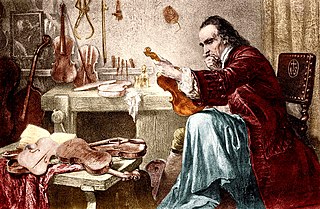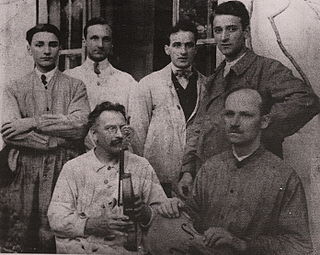Related Research Articles

Antonio Stradivari was an Italian luthier and a craftsman of string instruments such as violins, cellos, guitars, violas and harps. The Latinized form of his surname, Stradivarius, as well as the colloquial Strad are terms often used to refer to his instruments. It is estimated that Stradivari produced 1,116 instruments, of which 960 were violins. Around 650 instruments survive, including 450 to 512 violins.

A Stradivarius is one of the violins, violas, cellos and other string instruments built by members of the Italian family Stradivari, particularly Antonio Stradivari, during the 17th and 18th centuries.
The Guarneri, often referred to in the Latinized form Guarnerius, is the family name of a group of distinguished luthiers from Cremona in Italy in the 17th and 18th centuries, whose standing is considered comparable to those of the Amati and Stradivari families.

Giovanni Battista Guadagnini was an Italian luthier, regarded as one of the finest craftsmen of string instruments in history. He is widely considered the third greatest maker after Antonio Stradivari and Giuseppe Guarneri "del Gesù". The Guadagnini family was known for their violins, guitars and mandolins.

Jean-Baptiste Vuillaume was a French luthier, businessman, inventor and winner of many awards. His workshop made over 3,000 instruments.

Carlo Bergonzi was an Italian luthier and is the first and most prominent member of the Bergonzi family, a distinguished group of luthiers from Cremona, Italy, a city with a rich tradition of stringed instrument makers. Today his instruments are highly valued for their workmanship and tone. Although he was historically assumed to have first apprenticed with Hieronymus Amati or Antonio Stradivari, he is now known to have been the student of Vincenzo Rugeri.
Luigi Tarisio was an Italian violin dealer and collector.

Bartolomeo Giuseppe "del Gesù" Guarneri was an Italian luthier from the Guarneri family of Cremona. He rivals Antonio Stradivari (1644–1737) with regard to the respect and reverence accorded his instruments, and for many prominent players and collectors his instruments are the most coveted of all. Instruments made by Guarneri are often referred to as Del Gesùs.
Francesco Rugeri, also known as Ruger, Rugier, Rugeri, Ruggeri, Ruggieri, Ruggerius, was the first of an important family of luthiers, the Casa Rugeri in Cremona, Italy. His instruments are masterfully constructed. His violins are inspired by Nicolò Amati's "Grand Amati" pattern. Francesco was the first to develop a smaller cello design, which has become the standard for modern cello dimensions. Today, Rugeri's instruments are nearly as renowned as Nicolò Amati's instruments.

Igino (Iginius) Sderci was a violin maker who studied under master maker Leandro Bisiach. Making more than 700 instruments including many large violas, he won gold medals at the prestigious Stradivarius Exhibition at Cremona in 1937 marking the bicentenary of Stradivari's death.
Andrea Guarneri was an Italian luthier, musician and founder of the Casa Guarneri. He is the most important student of Nicola Amati and grandfather of one of the best luthiers, Bartolomeo Giuseppe Guarneri, del Gesù.

Ernst Heinrich Roth (1877–1948), also often referred to as Ernst Heinrich Roth I to distinguish him from later family members of the same name, was a German luthier and master of a large and successful violin-making workshop in the East German town of Markneukirchen, near the current border with the Czech Republic. He was the most important and distinguished figure in a whole dynasty of Roth luthiers active in Germany over many generations and to this day.
The Baron Knoop, ex-Bevan Stradivarius is a violin made by the celebrated luthier Antonio Stradivari in Cremona, Italy in 1715.

David Laurie - was a distinguished 19th century violin collector.
Giuseppe Giovanni Battista Guarneri, better known as Giuseppe filius Andrea Guarneri was a violin maker from the prominent Guarneri family of luthiers who lived in Cremona, Italy.

Tarisio Auctions is a web-based auction house that specializes in string instruments and bows. Founded in 1999 with locations in New York and London, its online auctions provide a global marketplace for musical instrument sales.

Nicola Amati, Nicolò Amati or Nicolao Amati was an Italian master luthier from Cremona, Italy. Amati is one of the most well-known luthiers from the Casa Amati. He was the teacher of illustrious Cremonese School luthiers such as Andrea Guarneri and Giovanni Battista Rogeri. While no clear documentation exists for their being apprentices in his shop, Amati may also have apprenticed Antonio Stradivari, Francesco Rugeri, and Jacob Stainer, as their work is heavily influenced by Amati.

Vincenzo Rugeri, was an Italian luthier of string instruments such as violins, cellos, and, violas in Cremona, Italy. His instruments are noted for their craftsmanship and tone quality. Vincenzo came from a distinguished family of luthiers, the first of whom was his father, Francesco Rugeri. Despite the local tradition of artisan families laboring together through generations, Vincenzo left the family shop and set up a successful shop of his own in the center of Cremona. Vincenzo was the third son of luthier Francesco Rugeri. Vincenzo's work, like Francesco's, is influenced by Nicolò Amati's Grand Pattern model, however Vincenzo's work was distinguished from his father's by utilizing a lower arch inspired by Antonio Stradivari. An analysis of the body of his work reveals that the quality of Vincenzo's instruments is remarkable, perhaps even more so than his father's. Vincenzo's instruments, though less numerous, are valued at least equal to those of his father. A violin by Vincenzo Rugeri realized $502,320 on October 3, 2011 at Brompton's Auctions in London. Carlo Bergonzi was a distinguished apprentice of Vincenzo Rugeri.

The Cremona Society of London was founded in 1886 for the study of the violin and other stringed instruments.

Horace William Petherick (1839-1919) was an artist and illustrator, a violin connoisseur, and a writer. As an artist, four of his works are in public collections in the UK; as an illustrator, he illustrated over 100 books, some of which are still in print, and his work can be found in digital collections at the British Library, the Osborne Collection of Early Children's Books, and the Baldwin Library of Historical Children's Literature; as a violin connoisseur, he owned both a Stradivarius and a del Gesù; and as an author, three of his books are still in print.
References
- ↑ The Guitar (From The Renaissance To The Present Day) by Harvey Turnbull (Third Impression 1978) - Publisher: Batsford. Images from the W. E. Hill & Sons Collection: plate 22c (Guitar by Alexandre Voboam dated 1652) and plate 23a/b/c (Chitarra Battente by Jacobus Stadler)
- ↑ Henley, William (1973). The Universal Dictionary of Violin and Bow Makers (2nd ed.). Brighton: Amati Pub. Ltd.
- W.E. Hill & Sons (A Tribute), Richard Sadler 1996 ISBN 0-9504357-2-4
- Giovanni Paolo Maggini: His Life and Work (1892) Henry, Arthur & Alfred Hill
- https://archive.org/details/giopaolomagginih00hugg
- The Hill Bow Makers 1880-1962, John Milnes and Derek Wilson 2016, ISBN 978-0-9549702-9-1